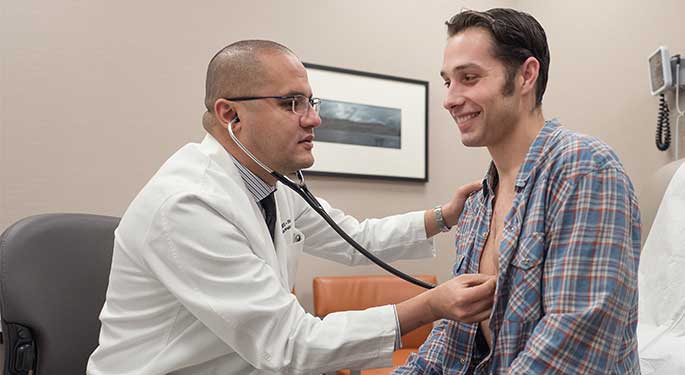Aortic Diseases and Surgery

If you have severe aortic stenosis, which happens commonly with severe calcification, or regurgitation, you may need a surgical procedure to replace your aortic valve. During this surgery, the damaged valve is removed and replaced with an artificial one.
An aortic aneurysm is a dilatation or “bulge” of the aorta, the main artery of the body. When a section of the aorta weakens and overstretches, it can tear and subsequently burst. Small aneurysms can be harmless, but large ones can burst and cause dangerous bleeding or even death. At Mount Sinai Fuster Heart Hospital, we have extensive experience in treating these cardiac issues.
Often aortic aneurysms do not cause any symptoms unless there is severe overstretching or a tear, which can trigger back pain and discomfort. At Mount Sinai Fuster Heart Hospital, we often detect an aortic aneurysm when doing an ultrasound or computerized tomography scan for another medical condition.
Aortic aneurysms are most common in men and in people over age 60. They affect about 15,000 Americans each year.
Why Choose Mount Sinai?
The Mount Sinai Hospital is a leading referral center for thoracic aortic aneurysms in the United States, not only because of its clinical expertise and history, but also because of our strength in basic clinical research.
The Society of Thoracic Surgeons has developed a comprehensive rating system for the quality of Coronary Artery bypass surgery and for the quality of Aortic Valve Replacement Surgery among hospitals across the country. Approximately 3% of hospitals received the "3 star" rating in both CAB and AVR, which denotes the highest category of quality. In the current analysis of national data covering the period from January 1, 2016 through December 31, 2016, both the Coronary Artery Bypass surgery as well as the Aortic Valve Replacement surgery performance of The Mount Sinai Hospital was found to lie in this highest quality tier, thereby receiving an STS 3-star rating.
At Mount Sinai Fuster Heart Hospital, we conduct research and provide advanced care for all aspects and stages of aortic aneurysm. In addition, our teams of cardiovascular surgeons, anesthesiologists, and physician scientists conduct research to better understand spinal cord and brain physiology as it relates to aortic treatment and surgery. Our findings enable us to continually improve our preoperative surveillance, surgery, and postoperative care.
We consider a host of factors in making treatment decisions: your age, height, gender, and overall health; presence of symptoms; and the aneurysm’s size and rate of growth. We use the latest and least invasive techniques to treat aortic aneurysm, including medication only, when appropriate. However, when medication does not suffice, we often use surgical procedures.
Aortic Aneurysm Surveillance Program
Established in 1985, Mount Sinai Fuster Heart Hospital’s Aortic Aneurysm Surveillance Program is one of the largest in the nation. Patients come from all over the world to participate in our program. We are a leading referral center for thoracic aortic aneurysms in the United States, thanks both to our clinical expertise and also our research in the field.
Our staff carefully monitors changes in the size of your aneurysm to provide the most effective, customized treatment. When you first come to Mount Sinai Fuster Heart Hospital, or before your discharge post-surgery, we perform a computerized tomography (CT) scan, where we take a variety of measurements and create a three-dimensional reconstruction of your aorta. You also meet with one of our aortic surgeons for a physical examination. Every patient in our program receives a CT scan regularly. We perform it every six months for patients with relatively large aneurysms and annually for those with smaller aneurysms. When you come in for your scan, one of our aortic surgeons will also examine you. After our radiologist reviews your scans, we will share your results with you, your cardiologist, and your primary care physician.